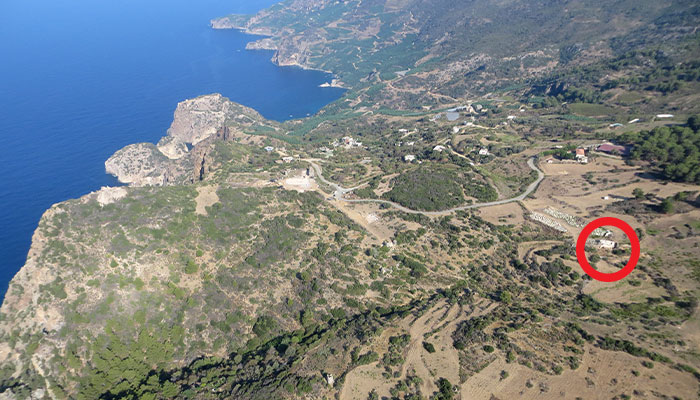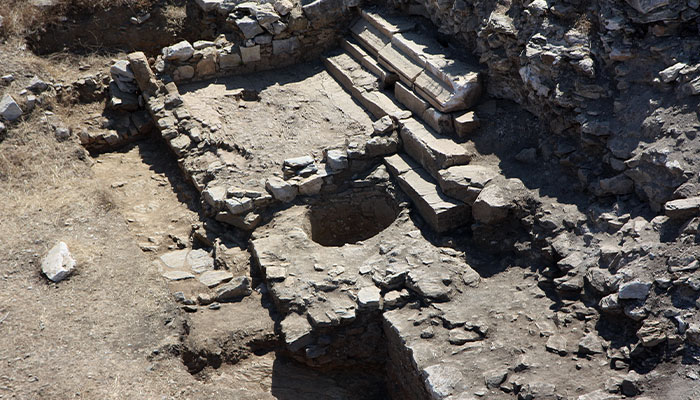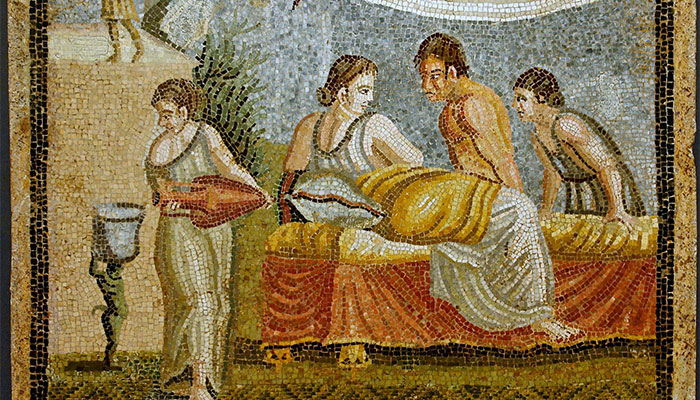The excavation of a Roman city on Turkey’s southern coast has led to the unearthing by Macquarie University archaeologist Dr Emlyn Dodd of an ancient winery like no other.

Drink of ages: Dr Emlyn Dodd in the Macquarie University History Museum with its collection of ceramic jars used to transport wine and oil around the Mediterranean. Photo credit: Michael Amendolia
Over three hot Turkish summers, digging through layers of dust and rocky soil encountering snakes and scorpions along the way, Dodd and the Antiochia ad Cragum Archaeological Research Project (ACARP) revealed the workings of a wine press unique in Turkey and the Mediterranean.
The search for a PhD project in the area of ancient food and drink had brought Dodd in 2014 to the excavation of the monumental ruins of Antiochia ad Cragum, a key harbour city – established in the 1st century AD – on the bustling trade route from Constantinople to Egypt and the Levant.
Since 2005, in a region known in antiquity as Rough Cilicia, ACARP has uncovered the remains of a Roman temple, churches, a city gate and colonnaded street, and a great bath complex including a spectacular 30-metre-long marble tile mosaic.
Dodd calculates that the press each vintage could have processed nearly 16 tonnes of grapes to make almost 11,000 litres of wine.
Among the many treasures brought forth from the earth was the wine-making installation physically attached – like only one other wine press ever discovered in the Mediterranean – to the side of a Roman imperial temple.
“It’s very unusual because you never really see any sort of agriculture happening at the same site as religion and worship, until the Christian era, when wineries and Churches became much closer,” says Dodd. As well, wine was typically made outside town walls and close to the grapevines to minimise juice loss and the cost of transportation.
ACARP, led by the University of Nebraska Lincoln, hadn’t done any analysis of the wine press, and Dodd was the person for the job. He had studied a Bachelor of Ancient History at Macquarie, and for his Honours project worked on a collection in the Macquarie University History Museum of huge ceramic jars that had been used for the transportation of wine and oil around the Mediterranean.
“ACARP didn’t really have an agricultural specialist on the team, and that is where I came in, to get there and spend a few seasons figuring out what exactly was happening at this press,” Dodd explains.

Digging deep: An aerial shot of Antiochia ad Cragum on Turkey's southern coast, the imperial Roman temple, site of the wine press, circled.
His findings, published in the prestigious Journal of Roman Archaeology and included in his recently published book Roman and Late Antique Production in the Eastern Mediterranean, underline the uniqueness of the wine press.
As well as being built into the side of a temple in about the 4th century AD, the press had been constructed with stone and mortar from the ground up, distinct from other wine presses discovered in Rough Cilicia that were carved out of the bedrock.
The temple, Dodd says, was dedicated to the Roman emperor and had likely been abandoned in the 2nd or 3rd century AD as Christianity began its rise in the Roman empire, so the press would have been built when the temple was in decline.
“This one has a large treading floor – about 3 metres by 2.4 metres, with room for four to five workers – and a very big vat for collecting and fermenting the must from the trodden grapes,” Dodd explains.
“It also has a niche which has been hacked out of the wall of the temple, suggesting there was a lever mechanism inserted into it, so they not only trod the grapes, but pressed them with a monumental wooden beam, probably carved from a tree trunk.”
Shadowy revelations
Using bespoke shadow-plotting software, Dodd established why the wine makers may have made their unusual choice: the temple’s western wall would have cast a full shadow from dawn until mid-afternoon across the treading floor, providing relief from the heat to the labourers crushing the grapes during the autumn vintage.

One of a kind: The Antiochia ad Cragum wine press, with the treading floor slightly above the round vat where the must from the grapes was collected and fermented.
First, though, the harvested grapes were probably laid out on the treading floor to expel their juices naturally, those first juices used to make the highest quality wine for the city’s elite, Dodd says.
It is also likely this premium drop was exported regionally, says Dodd, given the discovery of many kilns from the same era around the temple site and elsewhere in the city that were producing ceramic jars used to store and transport wine and oil.
As a next step, the grapes would have been trod to extract juice for mid quality wine, likely consumed by the regular citizens.
We have great evidence this type of wine was popular in the southern region of Turkey and shipped to Israel, Syria and Palestine to be used in Jewish rituals.
Lastly, the fruit would have been piled into reed baskets and the giant timber lever rammed into them to squeeze out the last of the juice, these mechanically pressed dregs being made into wine for the lower class and slaves.
Dodd calculates that the press each vintage could have processed nearly 16 tonnes of grapes to make almost 11,000 litres of wine.
“The whole treading floor area was covered in waterproof pink-red cement that is typical of Roman installations,” Dodd says.
“Then there is a ceramic pipe we found inserted into a wall of the treading floor – a rare find because they were often taken out and used for other purposes – that let the juice flow from the treading floor down to the vat.”
A sweet and popular drop
Dodd says the type of wine being made in the press is likely to have been a sweet raisin wine called passum, similar to passito wine made today in Italy.

Grape divide: Wine was thought to make women too rambunctious, leading to periods of prohibition in ancient Rome. Photo credit: 1st century AD marble mosaic from Centocelle, Rome, in the collection of Vienna's Kunsthistorisches Museum.
Two types of grapes, apiana and psithia, were used to make passum – their most likely equivalent today being the muscat grape of Alexandria, which genetic testing has traced back to antiquity, Dodd says.
The grapes would have been left on the vine beyond ripening, then picked and dried in the sun until becoming almost raisins, their weight halved and sugar highly concentrated.
“We have great evidence this type of wine was particularly popular in the southern region of Turkey and that it was shipped to Israel, Syria and Palestine to be used in Jewish rituals like Passover,” Dodd says.
- 'Good for the soul': The PM who loved poetry
- Budget blowouts and broken promises: How to avoid project failuers
“We also believe it was popular for church ritual and the early eucharistic ceremonies – because it was really sweet with a high alcohol content, it created a tipsy, celebratory kind of spiritual atmosphere when it was drunk in these ceremonies.”
Researchers also believe passum was popular among women because it was used in cooking and commonly found in kitchens.
“Through Roman history there were phases of prohibition where ancient Rome’s elite forbade women from drinking alcohol – they thought it made women too rambunctious – so we get descriptions about women sneaking a bit of passum when they’re in the kitchen,” Dodd explains.
“We know that men were well aware of this habit, and have evidence of an act called ‘ius osculi’ where male relatives (even cousins or relatives of the husband) could kiss the female to taste for alcohol on her breath.”
Wisdom of the ancients
His work on the wine press largely complete, Dodd hopes to return to Turkey this year and spread out across Antiocha ad Cragum to further map out its wine and oil industries.
He is also directing a survey project across the Cycladic islands of Greece investigating the ancient production of oil and wine.
“One of the things I am keen to look more into is to how these ancient techniques and tools can be applied to our own modern farming and agricultural practices, particularly in the context of climate change and sustainability,” Dodd says.
“In antiquity they made these practices sustainable for thousands of years. They also had climate crises that they overcame and maintained resilience and adaptability to, so looking at how they responded to that and how we can learn from those lessons is part of my job.”
Dr Emlyn Dodd is a Graeco-Roman archaeologist specialising in the study of ancient food and drink, agriculture, technology and trade. He has been newly appointed Assistant Director of Archaeology at the British School at Rome.



